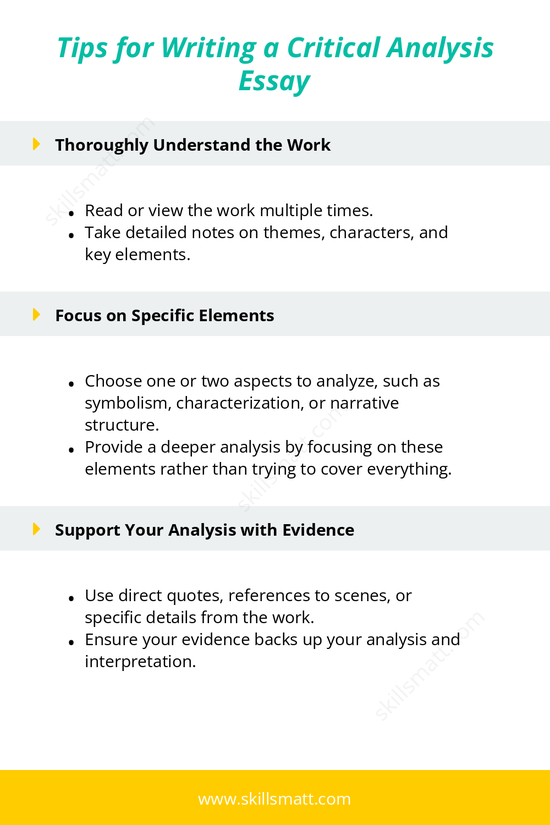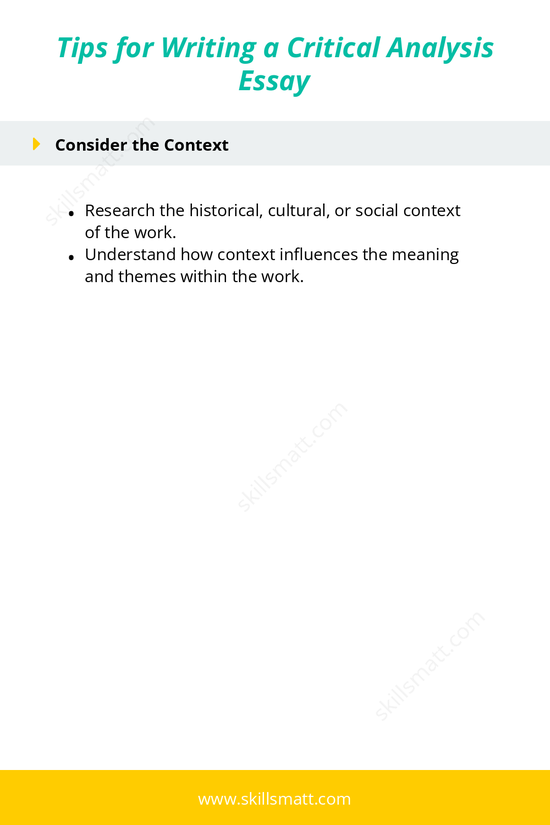Tips for Writing a Critical Analysis Essay
1. Thoroughly Understand the Work
- Read or view the work multiple times: It’s important to engage deeply with the text, film, or artwork. The first read-through can provide a general sense of the work, while subsequent readings allow for a closer examination of subtle details and nuances.
- Take detailed notes on themes, characters, and key elements: While reading, jot down notes on recurring themes, character development, important symbols, and key plot points. This will serve as a foundation for your analysis.
- Look for patterns and connections: Consider how various parts of the work interrelate. How do characters, events, or symbols connect to broader themes? Identifying these connections will help you form a coherent argument in your analysis.
2. Focus on Specific Elements
- Choose one or two aspects to analyze: A critical analysis essay is not meant to cover every element of a work. Instead, focus on specific aspects like symbolism, characterization, narrative structure, or themes. This allows you to provide a deeper and more focused analysis.
- Limit the scope: By narrowing your focus, you can provide a more in-depth evaluation of the chosen elements. For instance, if you are analyzing a novel, you might choose to focus on the author’s use of symbolism or how the protagonist’s character evolves.
- Analyze how these elements contribute to the overall meaning: Consider why the author or creator used certain techniques or elements. What do these choices reveal about the work’s themes or messages? This analysis will strengthen your argument.
3. Support Your Analysis with Evidence
- Use direct quotes and references: In order to support your analysis, use direct quotes from the text, or specific details from the film or artwork. Evidence from the work itself is crucial in lending credibility to your argument.
- Ensure evidence is relevant and well-explained: It’s important not to just drop quotes or references without explanation. Every piece of evidence should be clearly tied to your argument, helping to explain your interpretation of the work.
- Provide multiple examples: Instead of relying on a single instance to prove your point, use multiple examples from the work. This shows that your analysis is thorough and not based on an isolated incident.
- Contextualize your evidence: Ensure that you explain the significance of each piece of evidence. Don’t just quote the text—explain how it supports your analysis and what it reveals about the work.
4. Consider the Context
- Research the historical, cultural, or social context of the work: Understanding the context in which the work was created is essential to interpreting its meaning. Research the author’s background, the time period, and any social or political issues that may have influenced the work.
- Examine how context shapes the work’s meaning: Ask yourself how the historical or cultural context influences the way you interpret the work. For example, a novel written during a period of social upheaval might use certain themes or symbols to comment on societal issues.
- Explore the author’s intent: Try to understand the creator’s intentions and how they may have influenced the content of the work. Was the author trying to convey a particular message? How does the work reflect or challenge the prevailing ideologies of its time?
- Understand external influences: Take into account any personal, political, or societal events that may have shaped the work. This can provide deeper insight into the motivations behind the work and how it fits into a broader context.


